
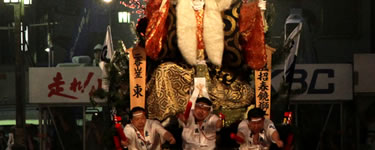
山笠/博多の見物スポット
YAMAKASA SIGHTSEEING SPOT
Kanazawa Shōko
2016.06.17
The well known Jōten-ji temple hosted an event on the 15th of May 2016 with the famous calligraphy master Kanazawa Shōko (金澤翔子). What make this calligraphy master especially interesting, is that she mastered calligraphy despite having down syndrome.
About the Jōten-ji (承天寺):
The Jōten-ji is a buddhist zen temple of the Rinzai sect in Fukuoka. It was founded 1242 by Enni Ben’en (円爾弁円), posthumously named Shōichi-Kokushi (聖一国師), after he had cured Hakata of a plague by sprinkling water on the towns people while being carried through the city on top of an altar, thus creating the Hakata-Gion-Yamakasa festival. The festival is today also deeply connected with the temple, as it is also an important stop during the festivals main event, the Oiyama.
Today the Jōten-ji is still lived in by monks and it holds events every now and again. In front of its main buddha hall there is a beautiful stone garden, thats stones are set up in wave patterns, creating the illusion one is looking at the ocean. The whole garden is still and yet one believes to hear the wind and the waves crashing against the larger rocks in the garden. The temple also harbours another famous, yet smaller garden. Within the temple buildings, completely surrounded by walkway and temple rooms, there is a significantly smaller, moss overgrown garden. Inside this garden are two little statues crudely carved out of rock.
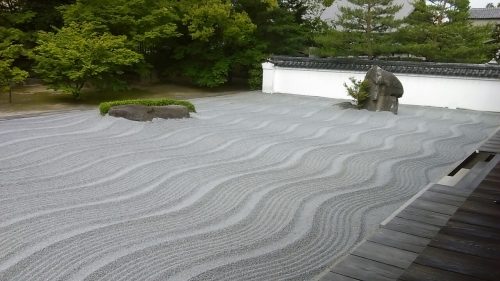
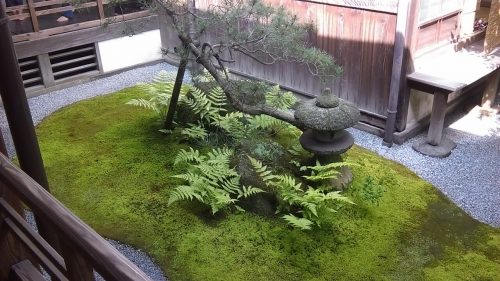
This beautiful scenery only complemented the calligraphy works, that were on display in most of the temple. Paper canvases of all sizes were arranged next to each other, each displaying a different set of Kanji, drawn in styles depending on their meaning.
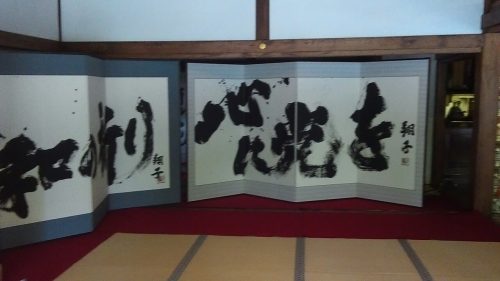
A lot of parents and their children with down syndrome were also invited to the event and came, their children dressed in traditional Japanese Yukata or Kimono. It was beautiful to see that having down syndrome does not mean you can not follow your dreams. If it is possible to reach mastery of the well respected art form of calligraphy, then whatever dreams the other, younger children had, would seem achievable through hard work alone.
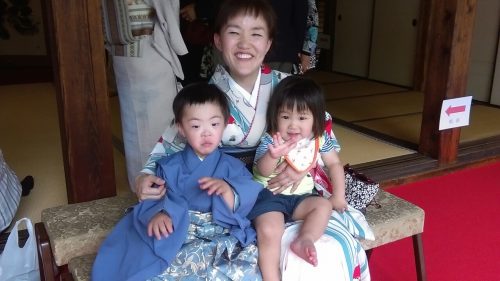
The main event of the day was seeing the 18 year old calligraphy master Kanazawa Shōko perform her art in form of four large symbols dedicated to the temple. The process of performing calligraphy is longer than one might think.
First the floor in front of the main altar, where the signs should be written, was covered with plastic sheets, in order to keep any ink from falling on the tatami floor. Then large sheets of black cloth were laid atop the plastic followed by the paper itself. The symbols should each be written on their own, about 1.5m by 1m large, piece of traditional Japanese paper, aka. Washi.
Next the ink, brush and signature stamp were prepared by assistant.
When everything was ready, a few small speeches were held by the organisers, the artists teacher and one of the temples monks.
The monks of the temple then sat before the paper and, facing the altar, chanted a religious song. Now it was time for the artist Kanazawa Shōko to write the characters. Everything fell silent as she wrote. She was assisted by her teacher, who put pieces of paper on top of parts she had written to make the ink dry faster, and an assistant, who carried the bowl of ink to each of the papers. The movements of the formerly so unconcentrated seeming artist took on a whole new certainty and she easily drew the complicated characters onto the paper.
The characters she drew where 神威佛光. The first character/Kanji is read as Kami and means “god”. The second one means “authority”/“might” and the third is an old Kanji for buddha, that today is usually written like this: 仏. The forth Kanji means “light” and together they can be roughly translated to “Gods power is Buddhas light”.
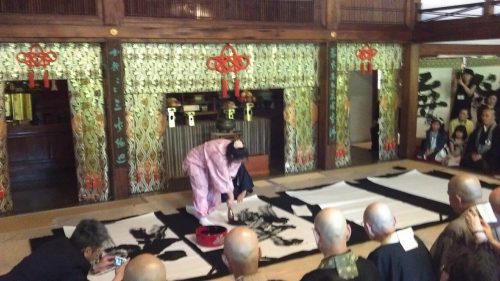
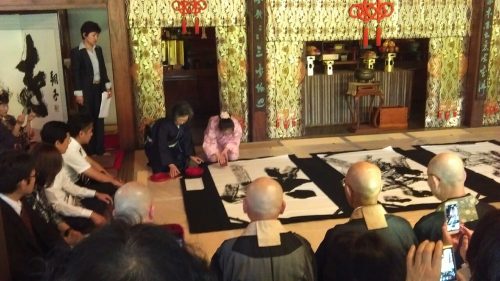
Todays calligraphy is all about finding your own style and perfecting your approach to the rules of how to prepare the tools and of the order of the lines. Though westerners like to see full lines, without any white within the line, this is not always possible with larger brushes and not a criteria for the beauty of the Kanji. To the beauty of the artwork the process of its creation is just as important as the end result, which is why the stroke order of the Kanji is strictly followed and there are no correcting changes to a written line. Each piece of calligraphy also captures the moment, in which it is written, such as the moment of every person in the Jōten-ji temple, including the children with down syndrome, watching in silent awe, while directly in front of the hall the stone garden makes it look as if even the sea is holding its breath as not to disturb the process.
I could not think of a better moment to further emphasise the artists personal style, as well as give the piece of art, that emerged, more meaning.
Sight seeing spot
Gourmet spot




